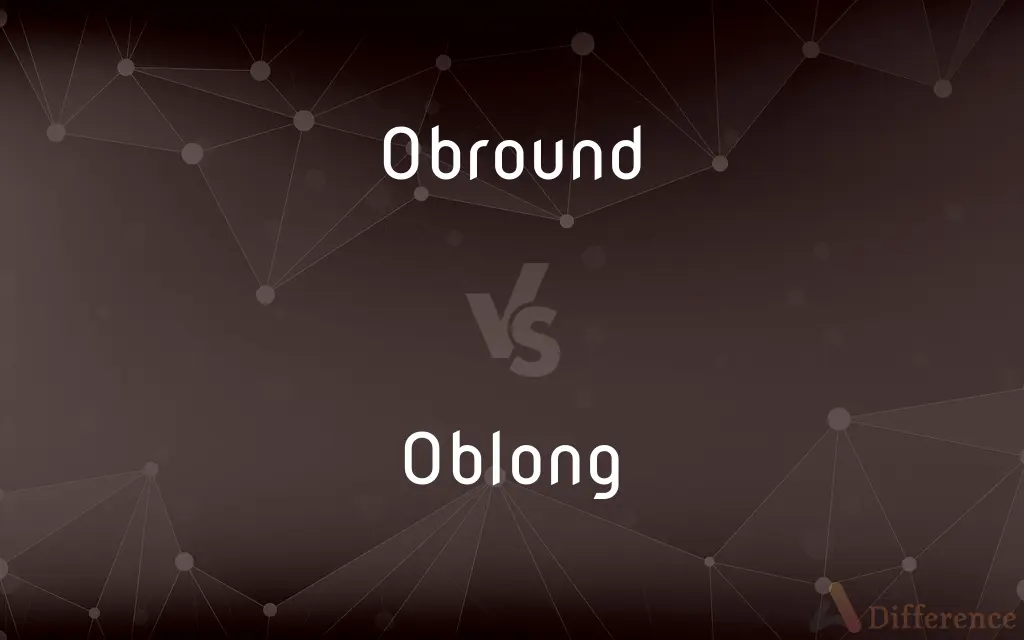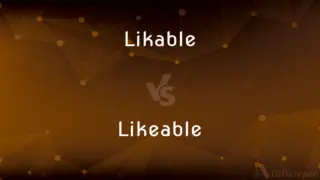Obround vs. Oblong — What's the Difference?
By Tayyaba Rehman & Fiza Rafique — Updated on April 7, 2024
Obround refers to a shape featuring rounded ends and straight sides, while oblong denotes a rectangular object longer than it is wide.

Difference Between Obround and Oblong
Table of Contents
ADVERTISEMENT
Key Differences
An obround shape is characterized by its straight sides connected by semicircular ends, creating a form that combines aspects of a rectangle and a circle. In contrast, an oblong is essentially a rectangle that is distinctly longer in one dimension, lacking the rounded ends characteristic of an obround. This distinction is crucial in engineering and design, where the specific shape can significantly impact functionality and aesthetic appeal.
Obround shapes are often used in mechanical design and manufacturing for holes, slots, or objects where a combination of straight and curved edges provides functional advantages, such as stress distribution or ease of assembly. On the other hand, oblong shapes are common in everyday objects like tables, rooms, and electronic device screens, where the elongated form factor is more about efficient use of space and visual appeal.
The term "obround" is more specialized, primarily used in technical fields like machining, carpentry, and engineering to describe specific geometric shapes. Conversely, "oblong" is a more commonly understood term, used in both technical and non-technical contexts to describe anything from architectural spaces to garden plots that are longer than they are wide.
In designing parts or spaces, choosing between an obround and an oblong shape may depend on the requirements for strength, fit, aesthetic preferences, or the need to maximize space. The obround's rounded ends can reduce stress concentrations, making it suitable for holes in metal parts, whereas the oblong shape might be chosen for its simplicity and ease of construction in architectural designs.
Both shapes reflect the diversity of geometric forms used in various disciplines, highlighting the importance of precise terminology in conveying design intentions and requirements. Whether choosing an obround for its mechanical benefits or an oblong for its spatial efficiency, understanding the distinct characteristics of each shape ensures their appropriate application.
ADVERTISEMENT
Comparison Chart
Shape Characteristics
Rounded ends with straight sides
Rectangular, longer than wide
Common Uses
Mechanical parts, holes, slots
Tables, screens, rooms
Field of Use
Engineering, machining
General design, architecture, everyday objects
Stress Distribution
Reduces stress concentrations at ends
Stress distributed along straight edges
Aesthetic Appeal
Functional with a specific aesthetic in technical applications
Often chosen for spatial efficiency and simplicity
Compare with Definitions
Obround
Characterized by a combination of circle and rectangle features.
The designer opted for an obround shape to combine aesthetic with function.
Oblong
Simple yet versatile in application.
The oblong garden bed allowed for more plant variety.
Obround
Utilized in engineering for specific functional benefits.
The obround slots made assembly easier and more precise.
Oblong
Common in everyday objects and designs.
Her new phone had an oblong screen, enhancing its display area.
Obround
Reduces stress concentrations in materials.
Obround openings are preferred in high-stress environments.
Oblong
Preferred for efficient use of space.
The architect designed oblong rooms to maximize the building's footprint.
Obround
A shape with rounded ends and straight sides.
The machinery part had an obround hole for better stress distribution.
Oblong
Often associated with aesthetic appeal in general design.
The oblong vase added a touch of elegance to the shelf.
Obround
Found in technical and mechanical designs.
The obround cutout was critical for the component's fit.
Oblong
A rectangle longer than it is wide.
The oblong table fit perfectly in the narrow dining room.
Obround
Somewhat round, roundish; = "obrotund".
Oblong
A rectangular object or flat figure with unequal adjacent sides
An oblong of grass
Obround
(geometry) A plane shape consisting of two semicircles connected by parallel lines tangent to their endpoints.
Oblong
Having the shape of an oblong
Oblong tables
Obround
A feature or component with an obround shape.
Oblong
Deviating from a square, circular, or spherical form by being elongated in one direction.
Oblong
Having the shape of or resembling a rectangle or ellipse.
Oblong
(Botany) Having an elongated form with approximately parallel sides
An oblong leaf.
Oblong
An object or figure, such as a rectangle, with an elongated shape.
Oblong
Having a length and width that are different; not square or circular.
Oblong
Roughly rectangular or elliptical.
Oblong
(bookmaking) Having the horizontal axis of a page longer than the vertical; In landscape orientation.
Oblong
Something with an oblong shape.
Oblong
A rectangle with length and width that are different.
Oblong
An ellipse with minor and major axes that are different.
Oblong
To extend so as to form an oblong shape.
Oblong
To give an oblong shape to.
Oblong
Having greater length than breadth, esp. when rectangular.
Oblong
A rectangular figure longer than it is broad; hence, any figure longer than it is broad.
The best figure of a garden I esteem an oblong upon a descent.
Oblong
A plane figure that deviates from a square or circle due to elongation
Oblong
Of a leaf shape; having a somewhat elongated form with approximately parallel sides
Oblong
Deviating from a square or circle or sphere by being elongated in one direction
Common Curiosities
Can obround and oblong shapes be used interchangeably?
No, they serve different functional and aesthetic purposes due to their distinct characteristics.
What is an obround shape?
An obround is a geometric shape featuring rounded ends connected by straight sides.
Why would someone choose an oblong shape?
Oblong shapes are chosen for their efficient use of space and visual appeal in design and architecture.
What defines an oblong shape?
An oblong shape is essentially a rectangle that is noticeably longer in one dimension than the other.
What are the aesthetic considerations for choosing an oblong shape?
Oblong shapes are often selected for their simplicity, spatial efficiency, and ability to fit into elongated areas attractively.
Where are obround shapes commonly used?
They're often used in mechanical design and manufacturing for parts requiring a mix of straight and curved edges.
How do obround and oblong shapes impact design functionality?
Obround shapes can offer mechanical advantages like reduced stress points, while oblong shapes are often chosen for spatial and visual design benefits.
Are obround shapes more complex to manufacture than oblong shapes?
Yes, the combination of straight and curved edges in obround shapes can make them more complex to manufacture than simple oblong shapes.
What factors influence whether to use an obround or oblong shape in a project?
Factors include the specific application's functional requirements, aesthetic considerations, and the physical properties needed in the final product.
How do cultural or stylistic preferences impact the choice between obround and oblong?
Cultural and stylistic preferences can guide the choice, with certain shapes fitting better within specific design philosophies or aesthetic traditions.
How do obround and oblong shapes compare in architectural design?
In architecture, obround might be chosen for unique structural or design elements, whereas oblong is often selected for room layouts and furniture for its spatial efficiency.
How does an obround shape affect stress distribution?
The rounded ends of an obround shape can help reduce stress concentrations, making it suitable for mechanical applications.
What is the significance of shape selection in design and engineering?
Shape selection is crucial for meeting functional requirements, aesthetic goals, and optimizing for manufacturing processes or spatial constraints.
Can the use of obround or oblong shapes be specific to certain industries or disciplines?
Yes, obround shapes are more specific to technical fields like engineering, while oblong shapes are widely used across various industries, including design and architecture.
Can the choice between obround and oblong affect the user experience?
Yes, the shape can impact user experience by influencing the usability, comfort, and visual appeal of objects or spaces.
Share Your Discovery

Previous Comparison
Fireworks vs. Blockbuster
Next Comparison
Likable vs. LikeableAuthor Spotlight
Written by
Tayyaba RehmanTayyaba Rehman is a distinguished writer, currently serving as a primary contributor to askdifference.com. As a researcher in semantics and etymology, Tayyaba's passion for the complexity of languages and their distinctions has found a perfect home on the platform. Tayyaba delves into the intricacies of language, distinguishing between commonly confused words and phrases, thereby providing clarity for readers worldwide.
Co-written by
Fiza RafiqueFiza Rafique is a skilled content writer at AskDifference.com, where she meticulously refines and enhances written pieces. Drawing from her vast editorial expertise, Fiza ensures clarity, accuracy, and precision in every article. Passionate about language, she continually seeks to elevate the quality of content for readers worldwide.














































